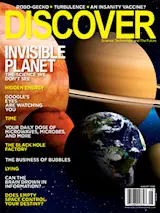“Press F1 for help.” When you’re working in a computer program and you get stuck, you can press a button and a handy guide pops up alongside whatever you’re puzzling over to clue you in. Wouldn’t it be great if real life worked that way? Out on the town, you could look at a restaurant, press a button, and get advice on whether the staff is surly or what wine to order. Motorola Labs, the research arm of the Schaumburg, Illinois, telecommunications giant, is developing a method to make that possible.The key is augmented reality (AR), a technology that combines stored digital data and information from the real world. A car navigational system is a simple form of AR: It works out your physical location using the Global Positioning System (GPS), consults a map database ,figures out a route to your destination, and provides a constant stream of directions to ...
A GPS to Augment Your Entire Reality
Your cell phone will provide the important linkage between the real world and the digital universe.
More on Discover
Stay Curious
SubscribeTo The Magazine
Save up to 40% off the cover price when you subscribe to Discover magazine.
Subscribe













